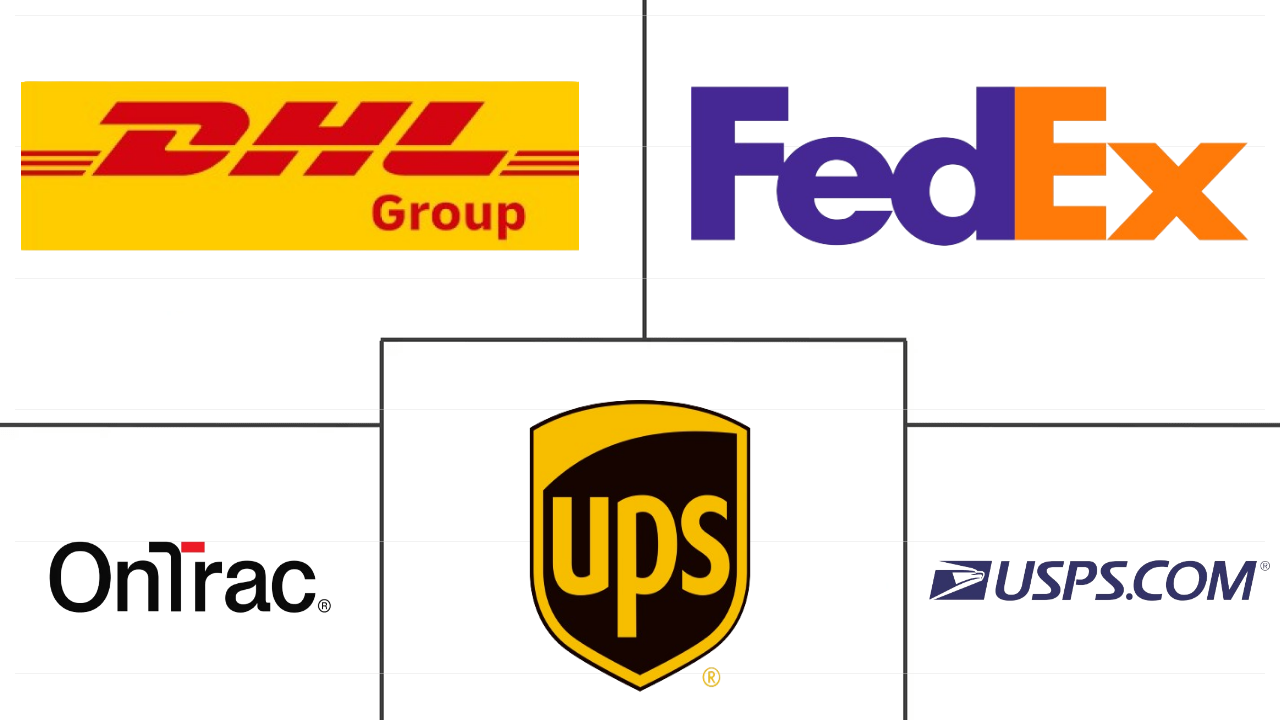Market Size of north america courier, express, and parcel (cep) Industry
|
|
Study Period | 2017 - 2030 |
|
|
Market Size (2024) | USD 206.06 Billion |
|
|
Market Size (2030) | USD 269.51 Billion |
|
|
Largest Share by Destination | Domestic |
|
|
CAGR (2024 - 2030) | 4.58 % |
|
|
Largest Share by Country | United States |
Major Players |
||

|
||
|
*Disclaimer: Major Players sorted in no particular order |
North America Courier, Express, and Parcel (CEP) Market Analysis
The North America Courier, Express, and Parcel (CEP) Market size is estimated at 206.06 billion USD in 2024, and is expected to reach 269.51 billion USD by 2030, growing at a CAGR of 4.58% during the forecast period (2024-2030).
206.06 Billion
Market Size in 2024 (USD)
269.51 Billion
Market Size in 2030 (USD)
3.52 %
CAGR (2017-2023)
4.58 %
CAGR (2024-2030)
Fastest Growing Market by Speed of Delivery
5.32 %
Projected CAGR, Express, 2024-2030
The demand for Speed of Delivery is driven by online orders for groceries, pharmaceuticals, and fashion goods, as the segment combines immediate product availability with the convenience of ordering from home.
Fastest Growing Market by Model
5.95 %
Projected CAGR, Business-to-Consumer (B2C), 2024-2030
The rising internet penetration in the region facilitates domestic and cross-border retail e-commerce, accelerating the model's growth and demand.
Largest Market by Shipment Weight
75.59 %
value share, Light Weight Shipments, 2023
Rising apparel manufacturing due to the increasing demand for these goods in the region is a major catalyst for the segment's share.
Largest Market by End User Industry
41.74 %
value share, E-Commerce, 2023
Consumers are making more online purchases due to e-commerce expansion and faster delivery speed offered to online shoppers in North America.
First Leading Market Player
36.33 %
market share, United Parcel Service of America, Inc. (UPS), Inc. (UPS)

UPS has 1,000 package operating facilities in the United States, with nearly 85 million sq. ft of space. It also has 63 facilities in Canada, with 2.6 million sq. ft of space.
The North American CEP market’s growth is being driven by e-commerce
- E-commerce has been a significant driver for growth in CEP deliveries. The e-commerce sales for the United States were estimated at USD 811 billion in 2022 and are expected to touch USD 1.36 trillion in 2025. Domestic and cross-border e-commerce have been major drivers for growth in the CEP market in North America. The domestic segment accounted for a 97% share of the US and Canadian e-commerce markets in 2022. Also, Mexico's domestic segment accounted for 94% of the e-commerce market. Online shopping orders from international retailers accounted for approximately 3% of retail e-commerce revenue in the United States and Canada in 2022. Mexico had the largest cross-border e-commerce share, with 6% as of 2022. Consumers in Mexico largely made purchases from the United States, accounting for about 50% of the cross-border e-commerce market.
- The expansion of e-commerce in Canada results from the number and variety of goods and services Canadians purchase that drive the domestic and international CEP markets. For instance, 55% of Canadians completed online retail purchases via mobile devices as of January 2022, wherein customers belonging to the millennial generation (those between the ages of 18 and 34) led the trend, with 47% making at least one weekly purchase online.
- In contrast with Canada, Mexico witnessed a marginal decline in e-commerce growth in 2022, whereas the retail industry, witnessed growth which contributed to growth of CEP industry. The e-commerce market witnessed a decline of 3.1% in Mexico in 2022 in comparison to 2021. The small parcel market has also driven this growth and boosted the domestic and international CEP markets in Mexico.
Infrastructure investments, adoption of robotic delivery cars, automated warehousing driving regional market
- The CEP market in the region is dominated by the United States, followed by Canada and Mexico. Major players in the market include Amazon, Canada Post Group, Correos de Mexico, DP DHL, FedEx, Royal Mail Group, UPS, and USPS. E-commerce in the region recorded growth at a CAGR of 17.75% during 2017-2021 with the growing cross-border trade and the adoption of new technologies, which are key factors driving the growth of the regional CEP market.
- Road network accounts for a significant share of parcel shipments in the region. However, the rising fuel costs, shortage of truck drivers and delivery personnel, and other disruptions impacted the operational cost of retailers. However, strong infrastructural initiatives, have been undertaken by the governments to upgrade the transit networks, such as the “Bipartisan Infrastructure Law" in US, worth USD 550 billion for 2022-2026. Robotic delivery cars, machine learning algorithms that enable customer experience, and warehouse automation are a few of the many innovations to pace up the regional CEP market.
- With rising parcel demand, many companies are undertaking mergers and acquisitions across the region. For instance, in October 2023, UPS Inc. acquired Happy Returns, a leading reverse logistics company, to enable easy and quick returns of parcels for merchants and consumers. Also, in 2021, Estafeta invested USD 97.5 million in improving its physical and digital infrastructure, including the construction of a new hub in Mexico City focused entirely on e-commerce. In 2023, FedEx announced the merger of FedEx Express and Ground operations in Canada to streamline parcel delivery operations.
North America Courier, Express, and Parcel (CEP) Industry Segmentation
Domestic, International are covered as segments by Destination. Express, Non-Express are covered as segments by Speed Of Delivery. Business-to-Business (B2B), Business-to-Consumer (B2C), Consumer-to-Consumer (C2C) are covered as segments by Model. Heavy Weight Shipments, Light Weight Shipments, Medium Weight Shipments are covered as segments by Shipment Weight. Air, Road, Others are covered as segments by Mode Of Transport. E-Commerce, Financial Services (BFSI), Healthcare, Manufacturing, Primary Industry, Wholesale and Retail Trade (Offline), Others are covered as segments by End User Industry. Canada, Mexico, United States are covered as segments by Country.
- E-commerce has been a significant driver for growth in CEP deliveries. The e-commerce sales for the United States were estimated at USD 811 billion in 2022 and are expected to touch USD 1.36 trillion in 2025. Domestic and cross-border e-commerce have been major drivers for growth in the CEP market in North America. The domestic segment accounted for a 97% share of the US and Canadian e-commerce markets in 2022. Also, Mexico's domestic segment accounted for 94% of the e-commerce market. Online shopping orders from international retailers accounted for approximately 3% of retail e-commerce revenue in the United States and Canada in 2022. Mexico had the largest cross-border e-commerce share, with 6% as of 2022. Consumers in Mexico largely made purchases from the United States, accounting for about 50% of the cross-border e-commerce market.
- The expansion of e-commerce in Canada results from the number and variety of goods and services Canadians purchase that drive the domestic and international CEP markets. For instance, 55% of Canadians completed online retail purchases via mobile devices as of January 2022, wherein customers belonging to the millennial generation (those between the ages of 18 and 34) led the trend, with 47% making at least one weekly purchase online.
- In contrast with Canada, Mexico witnessed a marginal decline in e-commerce growth in 2022, whereas the retail industry, witnessed growth which contributed to growth of CEP industry. The e-commerce market witnessed a decline of 3.1% in Mexico in 2022 in comparison to 2021. The small parcel market has also driven this growth and boosted the domestic and international CEP markets in Mexico.
| Destination | |
| Domestic | |
| International |
| Speed Of Delivery | |
| Express | |
| Non-Express |
| Model | |
| Business-to-Business (B2B) | |
| Business-to-Consumer (B2C) | |
| Consumer-to-Consumer (C2C) |
| Shipment Weight | |
| Heavy Weight Shipments | |
| Light Weight Shipments | |
| Medium Weight Shipments |
| Mode Of Transport | |
| Air | |
| Road | |
| Others |
| End User Industry | |
| E-Commerce | |
| Financial Services (BFSI) | |
| Healthcare | |
| Manufacturing | |
| Primary Industry | |
| Wholesale and Retail Trade (Offline) | |
| Others |
| Country | |
| Canada | |
| Mexico | |
| United States | |
| Rest of North America |
North America Courier, Express, and Parcel (CEP) Market Size Summary
The North America Courier, Express, and Parcel (CEP) market is experiencing significant growth, driven primarily by the surge in e-commerce activities across the region. The United States, Canada, and Mexico are the key players in this market, with the United States leading in terms of contribution to the GDP of the transportation and storage sector. The domestic e-commerce segment dominates the market, with a substantial share in the United States and Canada, while Mexico shows a strong cross-border e-commerce presence. The market is characterized by the presence of major companies such as Amazon, Canada Post Group, Correos de Mexico, DP DHL, FedEx, Royal Mail Group, UPS, and USPS, which are pivotal in shaping the competitive landscape. Innovations in logistics, such as robotic delivery cars and warehouse automation, are further propelling the market's expansion.
The CEP market's growth is also supported by infrastructural developments and strategic investments in transportation networks across North America. Initiatives like the Bipartisan Infrastructure Law in the United States and the National Trade Corridors Fund in Canada aim to enhance transit networks, thereby improving supply chain efficiency. Despite challenges such as rising fuel costs and a shortage of delivery personnel, the market remains robust, with companies engaging in mergers and acquisitions to strengthen their operations. The market's consolidation is evident, with a few major players holding a significant share. Additionally, fluctuations in fuel prices, influenced by global events and local policies, continue to impact operational costs, particularly in Mexico, where government subsidies help mitigate these effects.
North America Courier, Express, and Parcel (CEP) Market Size - Table of Contents
-
1. MARKET SEGMENTATION (includes Market Value in USD, Forecasts up to 2030 and analysis of growth prospects)
-
1.1 Destination
-
1.1.1 Domestic
-
1.1.2 International
-
-
1.2 Speed Of Delivery
-
1.2.1 Express
-
1.2.2 Non-Express
-
-
1.3 Model
-
1.3.1 Business-to-Business (B2B)
-
1.3.2 Business-to-Consumer (B2C)
-
1.3.3 Consumer-to-Consumer (C2C)
-
-
1.4 Shipment Weight
-
1.4.1 Heavy Weight Shipments
-
1.4.2 Light Weight Shipments
-
1.4.3 Medium Weight Shipments
-
-
1.5 Mode Of Transport
-
1.5.1 Air
-
1.5.2 Road
-
1.5.3 Others
-
-
1.6 End User Industry
-
1.6.1 E-Commerce
-
1.6.2 Financial Services (BFSI)
-
1.6.3 Healthcare
-
1.6.4 Manufacturing
-
1.6.5 Primary Industry
-
1.6.6 Wholesale and Retail Trade (Offline)
-
1.6.7 Others
-
-
1.7 Country
-
1.7.1 Canada
-
1.7.2 Mexico
-
1.7.3 United States
-
1.7.4 Rest of North America
-
-
North America Courier, Express, and Parcel (CEP) Market Size FAQs
How big is the North America Courier, Express, and Parcel (CEP) Market?
The North America Courier, Express, and Parcel (CEP) Market size is expected to reach USD 206.06 billion in 2024 and grow at a CAGR of 4.58% to reach USD 269.51 billion by 2030.
What is the current North America Courier, Express, and Parcel (CEP) Market size?
In 2024, the North America Courier, Express, and Parcel (CEP) Market size is expected to reach USD 206.06 billion.

